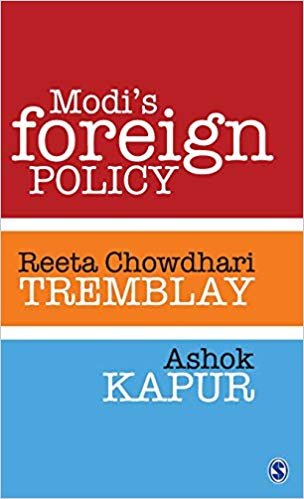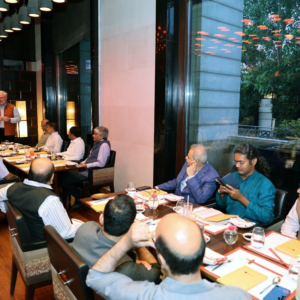Authors: Reeta Chowdhari Tremblay, Ashok Kapur
Publisher: SAGE Publications Pvt Ltd, 2017, pp. 256
Price: Rs.850/-
Book Review by: Ayanangsha Maitra
An Indian Prime Minister has always been the Minister-at-large of External Affairs.Even though there is a close-knit group for foreign policy making, the leadership style of the head of the government is really important factor for foreign policy formulation. Like his predecessors Nehru and Gujral, Prime Minister Modi has an impressive image in the realm of foreign affairs.
Modi kicked-off his diplomatic innings even before sitting on the throne of Prime Minister. He invited the South Asian supremos and that invitation elicited well responses. Right from the early days of honeymoon period, Modi has been in the glare of global media. Perhaps, no Indian Prime Minister understood the mediacracy better. Modi and Media eventually became friends. In the survey of ORB International’s International World Leader Index 2015, Modi ranked seventh.
ReetaChowdhari Tremblay and Ashok Kapur, two Canada based erudite academicians, take a close look at Prime Minister Modi’s foreign policy and reveal the observations in their book Modi’s foreign Policy. The work accounts roughly three years of Modi at the PMO. The 256-page-long exercise is divided into five distinctive, topical and incisive chapters, followed by an eighteen-page-long remarks.
The introductory chapter appears with a narrative – where the authors explain the parliamentary victory of Modi’s league BJP. According to Chowdhari Tremblay and Kapur, “Modi has been able to bring about a shift in the global thinking from a perception of Indian Foreign Policy that lacks direction to one that is coherent, well-articulated and proactive.”
The first chapter, A New Interpretative Framework of Foreign Policy is divided into a few broad sections. The chapter narrates how the protagonist, his PMO, MEA, Parliamentary Standing Committee, CCS work together – in order to achieve the foreign policy goals.
While talking about the goals of the Modi-Era, the authors have explained three main areas: neighbourhood re-conceptualization, bringing about multilevel alignments and projecting India as a global brand. Act East policy – a revised, reviewed and re-imagined version of Look East policy has been brought into functionality.At the same time, Modi has shown tremendous interest in Linking (the) West.
In the book, the duo has attempted to look beyond the Modi Mandate. The Indian Prime Ministers, as Walter Anderson says, “have maintained a free hand in the conduct of foreign policy due to the lack of effective parliamentary restrains on the PM.”
The policies, visions and choices of Nehru, architect of Indian foreign policy, are discussed concisely. The volume strives to find the differentiating factors in the external policies of Nehru and Modi.
“Nehru’s foreign policy prescriptions were ill-equipped to deal with the military requirements to counter hostile neighbours and to form a diplomatic strategy to counter the expansionist activities of Pakistan, the United States and China in relation to India during the 1950s and the 1960s,” opine the authors in the second chapter: The Nehruvian Legacy: Policy Anomalies and Policy Failure.
India’s foreign policy is very much traditional. The values of NAM, Panchasheel, Buddhism, Arthashastra are reflected in the foreign policy. But in certain cases, the foreign policy appears to be transformational. The views of Nehru, the architect of Indian foreign policy is given less importance in recent times. Hence, what Stephen Cohen calls -‘Militant Nehruvian’ foreign policy, clashes with the concept of conventional foreign policy.
Due to its huge economic growth in recent decades, India has exercised its greater power of influence. The third chapter, Extended Neighbourhood and Multilevel Alignments starts with the tale of Modi’s outreach to SAARC nations during 18th SAARC summit in Kathmandu. The outcomes from Indian ministers’ tête-à-tête with Asian and European leaders as well as several other summits are penned in the chapter. The reference of Heart of Asia conference comes often in the book.
The fourth chapter of the book is a stage – where the dragon dances with the elephant. The writers attempt to sniff the vapour of love between two Asian giants- China and India, in this chapter. Why the new equation comes in, or how the Beijing’s tryst with Islamabad begins, the book does not deny to disclose. Much attention is given to the changing dynamics of Sino-India relationships.“Nehru’s diplomatic rhetoric about China’s importance was an assertion, not an argument …Zhou Enlai’s writings also brought out the reality that China’s leaders operated on the basis of cold-blooded calculations and not on sentiments,” the authors indite.
The fifth Chapter, Pakistan Policy- Déjà vuor Something New appears to be inquisitiveas it seeks to explore the shift in the relationship of two nuclear neighbours. The chapter illustrates the bilateral issues in recent time and how the China’s BRI project effects the regional geo-politics. The chapter includes a wide range of issues – from the proxy war in Kashmir to Islamabad’s Sinophilia. Importance of CPEC is elucidated. Chowdhari Tremblay and Kapur are of the view that Modi has followed PM Vajpayee’s mantra of Insaniyat, Jamhooriyat and Kashmiriyat –while dealing with Kashmir. Modi once expressed, “It is my wish to complete the work started by Vajpayee.”
This chapter provides an analysis of the Comprehensive Bilateral Dialogue, chaired by Sushma Swaraj and Sartaj Aziz in detail. The discussion was fruitful and didnot end in an accusatory manner. When the two nations were expecting the dawn of hope, two attacks – in Uri and Pathankot by Pakistan-based terror outfits altered the situation. Addressing Islamabad, EAM Swaraj clearly stated, terror and talks cannot go together.
Modi’s India is entirely different from Nehru’s. There are hardly any similarity in the leadership. The shift in power has given birth to a parivartan in the governance. During the incumbency of coalition governments, the world saw a different India. The book does not neglect all those factors related to governance, and governments. But what makes the book – Modi’s Foreign Policy highly readable is eloquent analysis of the foreign policy of the Modi-squad. The publication also gives an account of the instrumentalists behind the big picture. EAM Swaraj, Foreign Secretary Sujatha Singh and her successor S Jaishankar, NSA Doval are among them. Their acts, views, visions and speeches can be found in the book.
The ‘authoritative take’ on Kashmiris immensely appealing. The authors have not just fleshed out how the Kashmir-factor matters even in dealing with foreign affairs, but enough amount of ink is spared to analyse the genesis of the Kashmir-smog. How the internal issues are impactive in foreign policy making and achieving domestic goals abroad – this book explains the readers.




